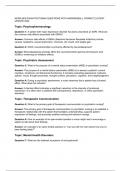Summary
Samenvatting Alle hoorcolleges A-T samengevat final + tentamenopgaven Consument & Marketing
- Course
- Institution
- Book
Dit is een uitgebreid document met een samenvatting van alle hoorcolleges Consument voor de Final. Elk hoorcollege + alle onderwerpen worden in de inhoudsopgave duidelijk weergegeven. Veel voorbeelden van de theorieën in te vinden. Aan het einde vind je voor elk onderwerp een voorbeeld tentame...
[Show more]













